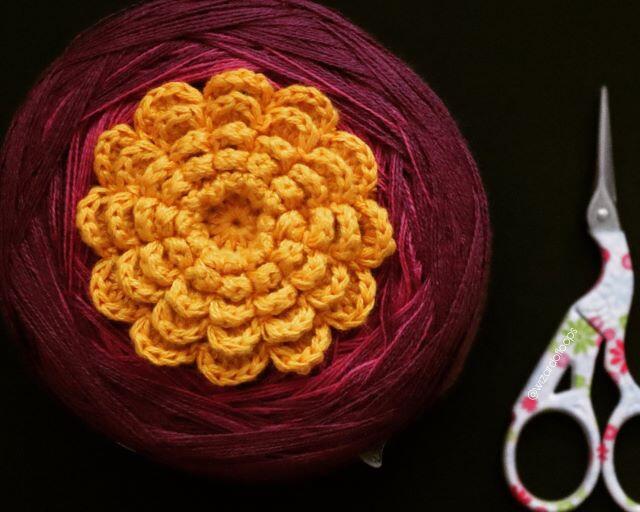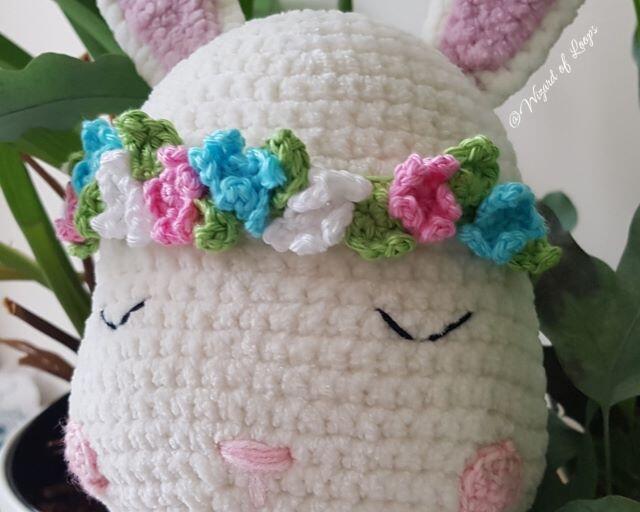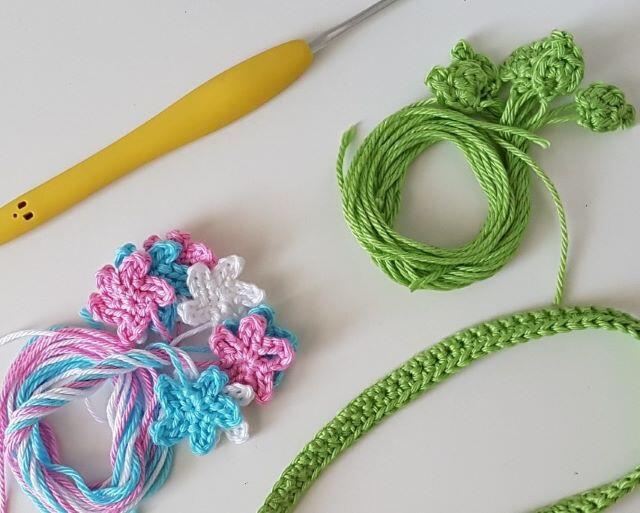Crocheting, an age-old craft, has seen a significant resurgence in popularity over the last few decades. Beyond its traditional use in creating cozy blankets and chic clothing, many enthusiasts are now taking up their hooks to craft intricate, colorful, and delightful crochet flowers. These handmade blooms capture the essence of nature’s beauty while lasting infinitely longer than their fresh counterparts. Let’s delve into the captivating world of crochet flowers and learn how to bring them to life.

Why Crochet Flowers?
- Longevity: Unlike fresh flowers which wilt and fade, crochet flowers stand the test of time. They’re a great way to immortalize a special moment or event.
- Versatility: They can be used in various projects like hair accessories, brooches, home décor, and even as unique gifts.
- Eco-Friendly: Crochet flowers reduce the environmental impact of disposing fresh blooms, plus they’re a sustainable way to enjoy flora without harming the environment.
- Customizable: You can play with colors, sizes, and designs. Want a blue rose or a giant daisy? No problem!
Are Flowers a Good Beginner Crochet Project?
For those just dipping their toes into the vast ocean of crochet, the question often arises: “What’s a good project to start with?” Crochet flowers are indeed an excellent choice for beginners, and here’s why:
- Size Matters: Crochet flowers are generally small, which means they’re quick to complete. This provides a sense of achievement in a short span, motivating newcomers to delve deeper into the craft.
- Basics First: While there are intricate flower designs available, many basic patterns only require knowledge of a few fundamental stitches. This makes them ideal for learning and mastering the basics.
- Mistake-Friendly: Given their organic nature, flowers are forgiving. A slightly larger petal or an uneven stitch might just add to the charm, rather than detracting from the overall look.
- Variety is the Spice of Life: There are countless flower designs, from simple daisies to elaborate roses. As beginners progress, they can choose more complex patterns, ensuring continuous learning without monotony.
- Functional Beauty: You can user even the simplest of crochet flowers as embellishments on hats, scarves, or bags. This functionality combined with beauty offers a satisfying purpose to every piece created.
So, to all budding crochet enthusiasts out there, flowers not only offer a delightful introduction to the craft but also bloom into a passion that can last a lifetime.
Getting Started: Basics Materials
- Yarn: Depending on the desired size and texture, you can opt for cotton, acrylic, wool, or even fine lace threads.
- Crochet Hooks: Usually, a size corresponding to the yarn weight will suffice, but it’s always good to have a range on hand.
- Pattern: There are countless free and paid patterns available online. For beginners, it’s recommended to start with simpler designs and gradually move to intricate ones.
- Scissors and a Tapestry Needle: For cutting off excess yarn and weaving in the ends.
Yarn for Crochet Flowers
Navigating the vibrant world of yarn can be as overwhelming as wandering through a botanical garden in full bloom. The sheer variety of textures, colors, and materials can be dizzying, but when crafting crochet flowers, certain yarns lend themselves particularly well to the delicate intricacies of crochet pattern in these creations:
Cotton Yarn
Renowned for its softness and stitch definition, cotton is a favorite among many crocheters for flowers. It’s smooth, durable, and available in a plethora of colors. Moreover, its natural feel evokes a certain rustic charm that’s reminiscent of nature.
Acrylic Yarn
Budget-friendly and widely available, acrylic yarn is a versatile choice. Its synthetic nature means it’s available in a wide spectrum of colors, including vibrant hues and pastels that might be hard to find in natural fibers.
Fine Lace or Thread
For those aiming to craft incredibly delicate and detailed flowers, like the ones you’d find on heirloom doilies, fine lace or crochet thread is the go-to. These fine threads allow for precision and are often used for more intricate designs.
Wool Yarn
While wool is often associated with warm and cozy winter projects, its natural texture can add depth and dimension to crochet flowers. Wool in softer shades can lend a vintage look to your floral creations.
Variegated Yarn
To achieve a multi-toned, organic look without changing yarns, variegated yarns are perfect. The gradual color changes can mimic the natural gradients seen in petals, adding a touch of realism.
Texture Matters
While smooth yarns are often preferred for clarity of stitches, don’t shy away from experimenting with textured yarns. Bouclé or chenille, for instance, can add a unique touch to your flowers.
When choosing yarn for crochet flowers, consider the project’s end purpose. If it’s a decorative piece that won’t face much wear and tear, almost any yarn will do. However, for functional items like clothing or accessories, durability is key. And remember, sometimes the most enchanting flowers bloom from unexpected yarn choices, so let your creativity run wild!
Crochet Flower Patterns: Blooming Inspirations and Where to Find Them
Embarking on the journey of crocheting flowers, one quickly realizes that patterns are the treasure maps guiding us to create those intricate, charming blossoms. Patterns provide step-by-step instructions, ensuring that each petal, loop, and stitch falls perfectly in place. But where does one find these guides, and free pattern especially without denting the wallet? Let’s explore:

Online Resources
- Ravelry: Often described as the Facebook for yarn enthusiasts, Ravelry is a vast online community where thousands of crochet patterns, including myriad flower designs, are available for free. Simply sign up, use the search function, and filter by ‘free’ to find a plethora of options.
- Blogs and Personal Websites: Many passionate crocheters document their journey and share their original patterns on personal blogs. Websites like Moogly, Attic24, and Repeat Crafter Me often offer free flower patterns, along with vivid photos and sometimes even video tutorials.
- YouTube: If you prefer a video tutorial. then consider haven for visual learners – YouTube as it boasts countless crochet tutorials. Channels like Bella Coco, HappyBerry Crochet, and The Crochet Crowd frequently delve into flower patterns, offering step-by-step video guidance.
- Online Crochet Groups and Forums: Platforms like Crochetville or certain Facebook groups have members who generously share their own patterns or links to free resources. Joining such communities can also provide support, tips, and a space to showcase your blossoming creations.
Offline Resources
- Libraries: In this digital age, let’s not forget the charm and resourcefulness of local libraries. Many carry crochet books that contain a treasure trove of flower patterns. Even if you can’t take the book home, a quick photocopy or snapshot of the pattern you like will serve you well.
- Crochet Magazines: Publications like Crochet World, Simply Crochet, and Interweave Crochet often feature flower patterns. While these magazines aren’t free, they’re often available at libraries or can be borrowed from fellow crochet enthusiasts.
Remember, while there’s a vast sea of free patterns available, always respect copyright rules. If a used flower pattern is free for personal use, avoid selling items made from it without the creator’s permission. As you dive into these resources, you’ll soon find that the world of crochet flower patterns is as diverse and beautiful as a wildflower meadow on a sunlit day.
What Can I Make Out of Crochet Flowers?
Diving into the world of crochet flowers, you might wonder, “Beyond the sheer joy of creation, what practical use do these floral wonders have?” The possibilities are as vast as a blooming meadow in springtime:
- Jewelry: Transform your crochet blossoms into stunning brooches, necklaces, or earrings. A crochet rose pendant or daisy earrings can be chic and unique fashion statements.
- Home Décor: Imagine a garland of crochet flowers draped over your mantel, or a vibrant bouquet that needs no water yet brightens up any room. They can also be used as table centerpieces, curtain tie-backs, or cushion embellishments. Crochet flowers make great part of the applique crochet works – Appliqué Crochet: The Art of Adding Flair to Your Crochet Projects.
- Hair Accessories: Attach your crochet creation to hairpins, bands, or even headbands for an instant touch of handmade elegance to your hairstyles.
- Greeting Cards and Gift Wraps: Add a personal touch to gifts and cards by adorning them with small crochet flowers. It adds a tactile and heartfelt dimension that recipients are sure to cherish.
- Clothing Embellishments: Elevate a plain sweater, hat, or bag by sewing on crochet flowers. This not only breathes new life into old outfits but also showcases your unique style.
- Bookmarks: For the book lovers out there, a slender crochet flower bookmark can make reading sessions even more delightful.
- Festive Decorations: Come Christmas, Easter, or any festive occasion, crochet flowers can be crafted to fit the theme, ensuring your celebrations have a cozy and personalized touch.
The beauty of crochet flowers is that they’re versatile and timeless. With a dash of creativity, you can incorporate them into countless projects, making everyday items bloom with artistry and charm.
Taking on your first crochet flower pattern
- Choose Your Pattern: Starting with a basic five-petal flower or a simple rose can be encouraging for first-timers.
- Understand the Instructions: Familiarize yourself with the crochet abbreviations and terms used in the pattern. If unsure, there are myriad online tutorials to guide you.
- Start Crocheting: Keep a steady tension on the yarn, and follow the pattern instructions carefully. With time and practice, the motions will become second nature.
- Finishing Touches: Once completed, you can add details like beads, buttons, or sequins in the center, or stitch them onto stems to create a bouquet.
Tips for Perfecting Your Crochet Flowers

- Practice Makes Perfect: As with any craft, the more you practice, the better you get. Don’t be discouraged by initial imperfections.
- Experiment with Colors: Nature doesn’t stick to a rigid palette, and neither should you. Mix and match to your heart’s desire.
- Stiffen Your Flowers: For flowers that you want to retain a particular shape, consider using fabric stiffeners or a light sugar water solution.
- Join a Community: There are many online and offline groups dedicated to crochet. Sharing your work, seeking advice, and admiring others’ creations can be immensely motivating.
Conclusion
Crochet flowers are a delightful fusion of art and nature. They symbolize patience, skill, and creativity. Whether you’re crafting a single bloom or an entire garden, the process is meditative and the results, always stunning. So, pick up that your crochet hook, choose your favorite colors, and let your imagination blossom! Also, check how crochet flower patterns can be made using AI: AI generated crochet patterns. Are they any good?